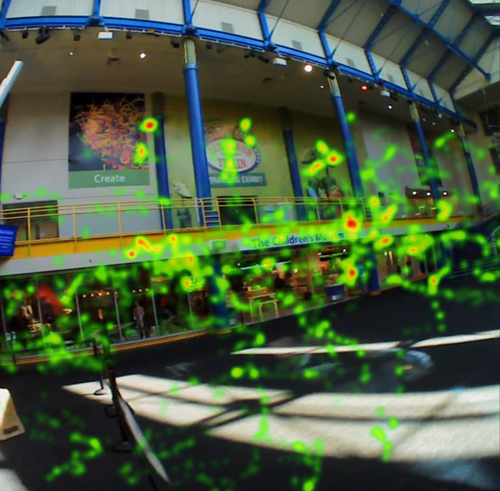 When visitors first enter The Children’s Museum of Indianapolis, they’re greeted by Bumblebee—the 17-foot, 2,000-pound robot prop that was used in the Transformers movie series.
When visitors first enter The Children’s Museum of Indianapolis, they’re greeted by Bumblebee—the 17-foot, 2,000-pound robot prop that was used in the Transformers movie series.
The statue is an attention grabber and practically impossible to miss as you pass by the Museum's Welcome Center. But after looking at it, where do the visitors' eyes go next? That was something Susan Foutz and the team at The Children’s Museum of Indianapolis wanted to find out. This summer, the University of Southern Indiana’s Biometrix Discovery Lab partnered with The Children’s Museum of Indianapolis on a wayfinding study. With the lab's eye-tracking glasses and technology, the goal of this partnership was to provide the museum with insights that could help them evaluate their current wayfinding efforts and signage at various places throughout the Museum.
“The Children's Museum of Indianapolis staff are always looking for ways to learn more about our constituents, including how they move through our educational experiences,” said Foutz, Director of Research and Evaluation at the Museum. “This was an opportunity to look at a different aspect of their visit—the entry and lobbies that are among the first areas families see when they arrive. We wanted to understand how first-time visitors to the Museum experienced the combination of wayfinding signage, marketing and membership messaging, and the showstoppers they see near our box office.”
Dr. Chad Milewicz, Coordinator of the Biometrix Discovery Lab and Chair of the Economics and Marketing Department in USI’s Romain College of Business, was put in contact with The Children’s Museum of Indianapolis through Dr. Sudesh Mujumdar, Dean of the Romain College of Business. After an initial Zoom call about the technology, Milewicz visited the Museum and gave staff members in the marketing and public relations division a demonstration of the technology.
Once they saw the technology in action, they realized just how helpful the information they received from the research could be. With the data gathered from these wayfinding studies by using eye-tracking glasses, The Children’s Museum of Indianapolis team was able to get a whole new look at how guests truly navigate their Museum.
 “The data we received from the eye tracking technology is something we would have been hard pressed to collect any other way,” Foutz said. “We walk by these areas and signs every day, so it's difficult for us to put ourselves in the shoes of a new visitor to the Museum. Combining the visitors’ viewpoints and the analysis Chad (Milewicz) provided with our own understanding of how people move in the space and what we are trying to communicate, we were able to take a step back and reconsider our approach.”
“The data we received from the eye tracking technology is something we would have been hard pressed to collect any other way,” Foutz said. “We walk by these areas and signs every day, so it's difficult for us to put ourselves in the shoes of a new visitor to the Museum. Combining the visitors’ viewpoints and the analysis Chad (Milewicz) provided with our own understanding of how people move in the space and what we are trying to communicate, we were able to take a step back and reconsider our approach.”
This is the latest partnership for the Biometrix Discovery Lab. In the past, the Lab has collaborated with Berry Global’s Blue Clover Studios, Midwestern Pet Foods and Learn More Indiana—an initiative of the Indiana Commission for Higher Education.
This partnership has had a positive impact for everyone involved. While the research has elicited new information for The Children’s Museum of Indianapolis, this collaboration has also created even more visibility for the Biometrix Discovery Lab, Romain College of Business and USI as a whole.
“Partnering with the largest children’s museum in the United States absolutely helps the visibility and reputation of the lab,” Milewicz said. “Whether it is a potential student or a potential organizational partner, when someone sees or hears we are partnering with The Children’s Museum of Indianapolis, it catches their attention.”
This study has already helped pique the Museum staff’s interest in potentially doing more biometric research in the future. They’ve already pinpointed a few different areas such as different locations in the Museum, marketing studies and educational studies as other areas where similar research studies could prove beneficial.
“I conduct a lot of visitor studies in the Museum, and this one, more than most, has really energized the staff. I think that’s because of the ’cool factor’ of the tech, but also because you are seeing the visitor’s point of view,” Foutz said. “With staff buy-in and useful data, I think we will use the results to make changes to the look of our entry environment.”
Milewicz is hopeful students will also take note of these studies and want to discover similar insights themselves. With a variety of opportunities to use the Biometrix Discovery Lab in both classroom and experiential learning, he wants them to be aware of the different possibilities this facility has to offer.
“As students, faculty, and organizations around our community learn about this project, I hope it sparks their curiosity in applying biometric research in their work or area of study,” said Milewicz. “Our lab is an excellent resource for USI and our region. I look forward to starting additional projects with people across campus and organizations throughout our region.”

